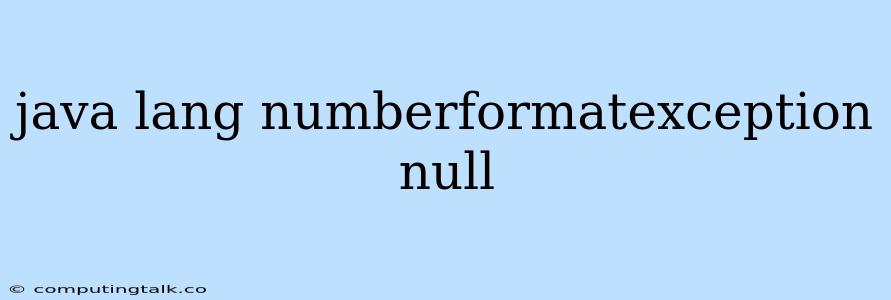The java.lang.NumberFormatException is a common error encountered in Java programming, often thrown when you attempt to convert a string to a numeric value, but the string does not represent a valid number. One of the primary reasons for this exception is encountering a null value during the conversion process.
Understanding the NumberFormatException
The NumberFormatException is a runtime exception that indicates a problem with the format of a number. It occurs when you try to parse a string into a numeric data type, such as int, double, or long, but the string is not in a format that the parser can recognize.
The Role of null in the Exception
A null value represents the absence of a value. When you attempt to convert a null string into a number, the conversion process fails, resulting in the NumberFormatException. This is because null does not represent a valid numeric representation.
How to Handle NumberFormatException
-
Check for Null Values: Before attempting to parse a string, always check if it's
null. You can use anifstatement or theObjects.isNull()method to determine if the string isnull.String str = null; if (str != null) { // Perform the conversion } else { // Handle the null case } -
Use a Try-Catch Block: Utilize a
try-catchblock to handle theNumberFormatExceptiongracefully. Thetryblock will attempt the conversion, and thecatchblock will execute if an exception occurs.String str = "abc"; try { int number = Integer.parseInt(str); // Use the parsed number } catch (NumberFormatException e) { System.out.println("Invalid number format: " + e.getMessage()); // Handle the error, such as providing a default value or logging the exception } -
Validate Input: Implement validation to ensure the input string is a valid number before attempting the conversion. Regular expressions can be used to check if the string matches a specific numeric pattern.
String str = "123"; if (str.matches("\\d+")) { // Matches any sequence of digits // Proceed with the conversion } else { // Invalid input } -
Use a Wrapper Class: The
Integer,Double, andLongwrapper classes have convenient methods for parsing strings. These methods can handle potentialNumberFormatExceptions.String str = "123"; Integer number = Integer.valueOf(str); // Uses a wrapper class for parsing -
Consider Optional: In Java 8 and above, you can use the
Optionalclass to represent the presence or absence of a value. This can help you handlenullvalues gracefully.Optionalstr = Optional.ofNullable("123"); if (str.isPresent()) { // Proceed with the conversion } else { // Handle the absence of a value }
Common Causes of java.lang.NumberFormatException: null
- Missing Input: When the user does not provide any input, the string variable will be assigned a
nullvalue, leading to the exception. - Incorrect Data Type: If the string contains characters or symbols other than numeric digits, it cannot be parsed into a number.
- Null String from Database: When retrieving data from a database, a field might have a
nullvalue, which can trigger the exception during conversion.
Examples
1. Missing Input:
String str = null; // No input, so str is null
try {
int number = Integer.parseInt(str);
} catch (NumberFormatException e) {
System.out.println("Invalid number format: " + e.getMessage());
}
2. Incorrect Data Type:
String str = "abc";
try {
int number = Integer.parseInt(str);
} catch (NumberFormatException e) {
System.out.println("Invalid number format: " + e.getMessage());
}
3. Null String from Database:
// Assuming a database connection and query
String str = resultSet.getString("age"); // "age" field might be null
try {
int age = Integer.parseInt(str);
} catch (NumberFormatException e) {
System.out.println("Invalid age format: " + e.getMessage());
}
Conclusion
The java.lang.NumberFormatException is a common exception in Java programming. The most frequent cause is the presence of a null value. Handling this exception effectively involves checking for null values, using try-catch blocks, validating input, and considering wrapper classes or Optional for a more robust solution. By implementing these best practices, you can prevent the exception and ensure the smooth conversion of strings into numbers in your Java applications.
